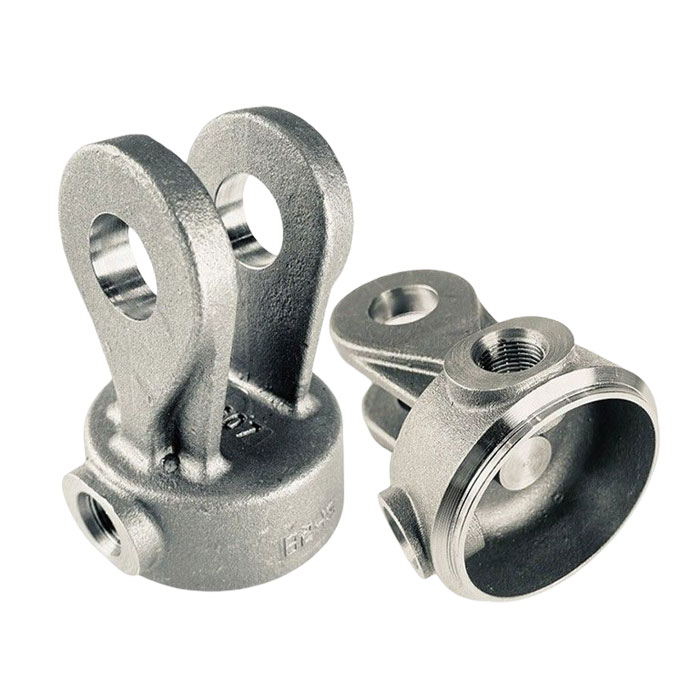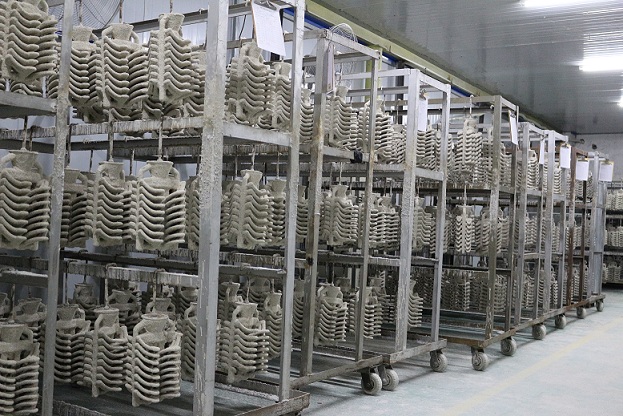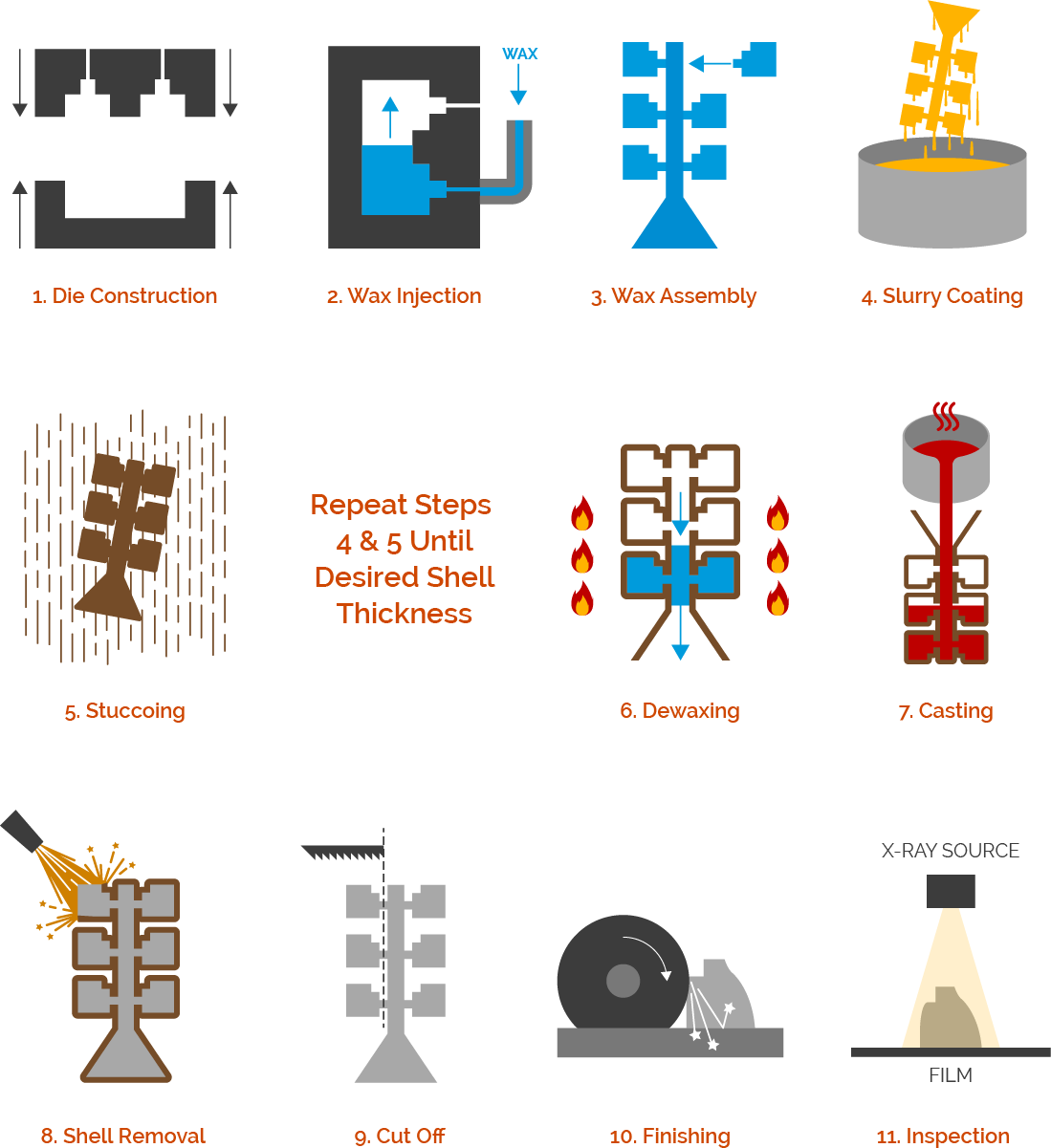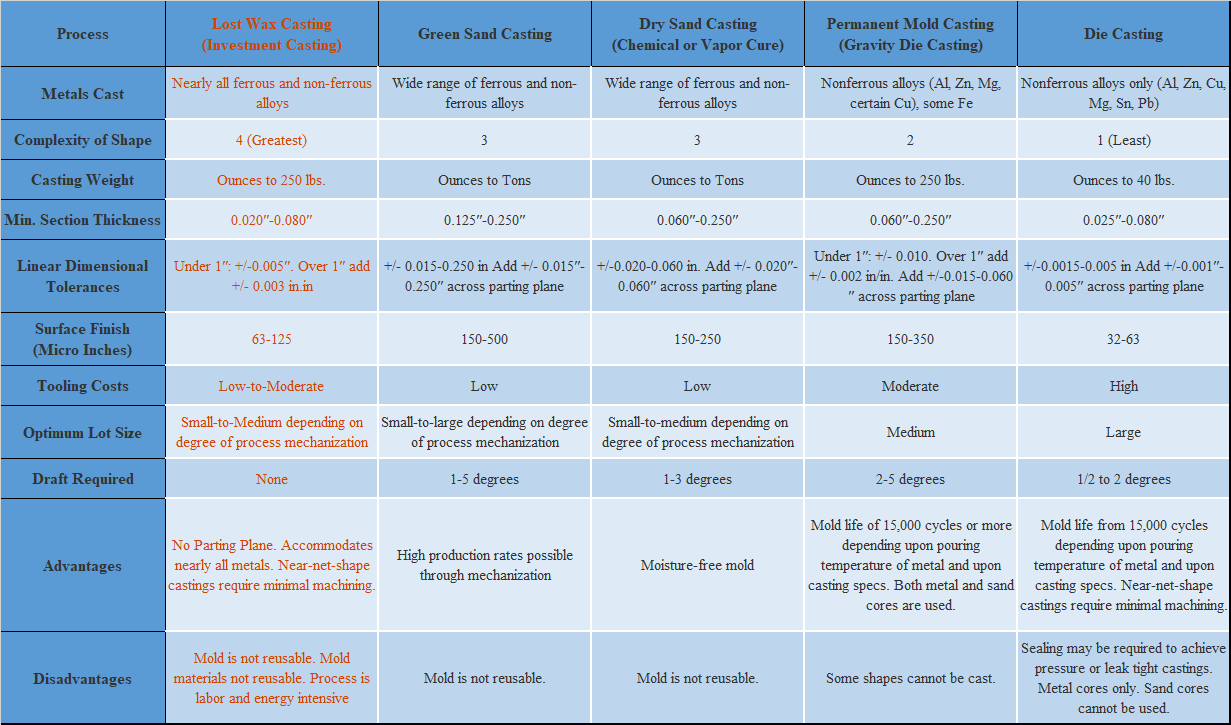
Hot selling Lost Wax Casting Suppliers.
Being supported by an highly developed and specialist IT group, we could supply technical support on pre-sales & after-sales service for Big discounting China Youlin® Lost Wax Casting, Our highly specialized process eliminates the component failure and offers our customers unvarying quality, allowing us to control cost, plan capacity and maintain consistent on time delivery.
Big discounting China Lost Wax Casting, Our products are mainly exported to Europe, Africa, America, the Middle East and Southeast Asia and other countries and regions. Now we have enjoyed a great reputation among our customers for quality products and good services.We would make friends with businessmen from at home and abroad, following the purpose of "Quality First, Reputation First, the Best Services."
1.Our Capacity for Metal Sand Castings
 Youlin® Lost wax casting, also known as precision casting or investment casting, is a manufacturing process in which a wax pattern is used to shape a disposable ceramic mold. A wax pattern is made in the exact shape of the item to be cast. This pattern is coated with a refractory ceramic material. Once the ceramic material is hardened, it is turned upside-down and heated until the wax melts and drains out. The hardened ceramic shell becomes an expendable investment mold. Molten metal is poured into the mold and is left to cool. The metal casting is then broken from of the spent mold.
Youlin® Lost wax casting, also known as precision casting or investment casting, is a manufacturing process in which a wax pattern is used to shape a disposable ceramic mold. A wax pattern is made in the exact shape of the item to be cast. This pattern is coated with a refractory ceramic material. Once the ceramic material is hardened, it is turned upside-down and heated until the wax melts and drains out. The hardened ceramic shell becomes an expendable investment mold. Molten metal is poured into the mold and is left to cool. The metal casting is then broken from of the spent mold.
The term investment casting is derived from the process of “investing” (surrounding) a pattern with refractory materials. Investment casting is often selected over other molding methods because the resulting castings present fine detail and excellent as-cast surface finishes. They can also be cast with thin walls and complex internal passageways. Unlike sand casting, investment casting does not require a draft.
These process qualities can provide net shape or near-net shape castings, which provide customers with significant cost savings in material, labor, and machining. It can make use of most common metals, including aluminum, bronze, magnesium, carbon steel, and stainless steel. Parts manufactured with investment casting include turbine blades, medical equipment, firearm components, gears, jewelry, golf club heads, and many other machine components with complex geometry.
2.Advantages and Disadvantages of Lost Wax Casting
Advantages:
✔Parts with extremely complex shapes and intricate features can be cast as a single piece using investment casting
✔With short length or shallow depth feature, thin sections down to 0.40 mm (0.015 in) can be cast without cold shut defects
✔Lost wax casting has excellent dimensional accuracy and tighter tolerances of 0.075 mm (0.003 in) are easily achievable.
✔Compared to similar manufacturing processes, lost wax casting can achieve excellent surface finish without any post-processing. Typically around 1.3 – 0.4 microns RMS Ra
✔It offers almost unlimited freedom in terms of investment cast materials, but most common materials used include Aluminum alloy, cast iron and non-ferrous alloys. The process is particularly attractive for high-temperature alloys.
✔Draft on walls are not required but if a master die is used to make wax patterns then draft on the face would help the pattern making process easier.
✔Since there are no parting lines, the cast would not have any flash. But the wax patterns might have parting lines from the master die.
✔Additional machining can be eliminated or reduced and allowance of as little as 0.4 to 1 mm (0.015 to 0.040 in.) usually enough.
✔Excellent dimensional precision can be achieved in combination with very smooth as-cast surfaces. These capabilities are especially attractive when making products from the high-melting temperature, difficult-to-machine metals that cannot be cast with plaster- or metal mould processes.
✔The wax used can usually be recovered for reuse.
Disadvantages:
✖Compared to other methods of metal casting, lost wax casting involves many complex steps making the process relatively expensive. But some of the steps can be automated for certain products. It can be more expensive than die casting or sand casting, but per-unit costs decrease with large volumes.
✖The high cost of dies to make patterns has traditionally limited investment casting to large production quantities
✖The high cost is also due to specialised equipment requirement, costly refractory material, and high labour cost
✖Parts are difficult to cast if they require cores, got holes smaller than 1.6 mm or deeper than 1.5 times the diameter
3.The Process Step of Lost Wax Casting

The following steps are what we follow to produce parts with complex geometries and intricate details.
1.Create wax pattern: A pattern that replicates the finished part geometry is made using one of two primary methods:
a.Build a wax injection die
b.3D print pattern
i.If a wax injection die will be used, the first step involves designing and building a metal die from Aluminum. This die creates a wax replica of the desired part by injecting melted wax under high pressure into the cavity. The die can be made as a simple one cavity manual tool or a complex multi-cavity automatic tool depending on volume requirements.
ii.If a 3D printed pattern will be used, a CAD model which contains the part geometry is sent to a printer and the part is printed.
2.Wax Assembly: Next, the wax patterns are assembled onto runners and into a finished tree which is ready to be dipped.
3.Slurry Coating: The assembly is then dipped into a high-grade ceramic slurry to build a ceramic shell around the wax tree.
4.Stuccoing: After the slurry coating is done, particles of sand are dropped onto the surface of the wet tree assembly. This helps to thicken and strengthen the layer of coating on the wax assembly surface.
5.Repeat Steps 5 and 6: Repeat steps 5 and 6 until the assembly achieves the desired shell thickness. The assembly is then allowed to set and dry.
6.Dewaxing: The wax inside the newly built shell is now removed. Dewaxing is done using a steam-dewaxing autoclave or flash fire furnace.
7.Casting: Now the desired molten metal is poured into the pre-heated mold cavity.
8.Cooling: The mold then sits to allow the molten metal to cool and solidify which then becomes the final casting.
9.Shell Removal: The shell material is then removed through processes hammer knockout, vibration, and steel grit blasting.
10.Cut Off: The finished parts are then cut free from the gating and runner system.
11.Finishing: Various finishing techniques are then employed including grinding, sand blasting and coating to achieve the final surface needed.
12.Testing: Once the finishing operations are done, the parts are inspected for surface and sub-surface defects. Visual and fluorescent penetrant inspection is done for surfaces and X-ray is employed for sub-surface defect identification.
4.Lost Wax Casting vs Other Casting Process

5.FAQ
Q: What are the considerations when using lost wax casting?
A:
1.Tooling Cost:
For low quantity requirements, it may be more expensive than other methods if permanent tooling is pursued. For those applications, SLA or printed patterns may be a cost-effective alternative (even for a quantity of one).
Initial costs are another key factor when determining whether investment casting brings the greatest value. The investment cast tool usually consists of multiple parts fitted together to produce the complex components. This “front end” cost is not insignificant but can be easily offset by the lack of subsequent machining and/or fabrication.
2.Size Limitations:
It’s possible to create investment castings in a range of sizes. There is an upper limit on that range, which is less than other shaped technologies like sand casting.
3.Very Small Structures:
Investment casting is an excellent choice for thin-walled applications, but very small internal shapes that use cores can present challenges. Holes typically cannot be smaller than 1/16” (1.6mm) or deeper than 1.5 times in diameter.
4.Timing:
The multi-step investment casting process is more time consuming than other processes. The processing time can be shorter than other alternatives.
Q: Why is it called lost wax casting?
A: After closing the mold around the clay model, hot wax is poured into the gap between the model and the mold. This causes the wax to melt and flow out of the mold, leaving a space between the fire resistant clay model and the investment mold. This is why this method is called the lost wax process.
Q: How accurate is investment casting?
A: Investment casting can achieve excellent detail and accuracy – in +/- 0.005 inch per inch range. Very little additional machining is necessary for details and features.